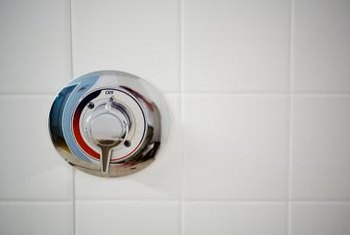Read article : How to Convert a Dual Valve to a Single Mixer Shower Fixture | Home Guides

Converting to a single-mixer shower valve can be done without a major remodel of the bath.
A two-handle shower faucet is installed through two small holes in the shower wall, and a single-lever faucet requires a single larger hole in the shower wall. When replacing a two-valve faucet with a single-mixer faucet, you are left with the challenge of the two existing holes from the old faucet. You will need to repair the wall to cover the two holes from the old faucet or use a repair escutcheon plate to cover all three holes.
Turn off the water supply to the shower faucet; this may require turning off all the water to the house. Remove the handles from the dual-valve faucet. Remove the escutcheon plates from behind the faucet handles. Remove the shower head by turning it counterclockwise.
Remove the access panel on the back side of the shower behind the faucet area. If an access panel doesn't exist, open the wall on the back side of the shower by cutting the drywall with a utility knife. Open the wall directly behind the existing shower faucet. Make the hole at least 12 inches square; you can increase the size later if needed for more working space. Locate the water pipes that supply the shower faucet.
Disconnect the pipes from the two-valve faucet. If the pipes are galvanized steel, unscrew the union nuts that join the faucet and pipes. If the pipes are copper, use a copper tubing cutter to cut the pipes about 6 to 12 inches away from the faucet. If the pipes are plastic, use plastic pipe cutting snips or a hack saw. Do the same with the pipe that supplies the shower head. Remove the faucet from the wall.
Attach short pieces of new pipe, 6 to 12 inches long, to the new faucet. Use the type of pipe your new faucet requires. If it's copper, you will need to solder the pieces into the faucet. If it has threaded connections, you can use male adapters that will transition to the type of pipe you want to use -- copper; chlorinated polyvinyl chloride plastic, or CPVC; or PEX, a flexible type of plastic tubing. Some faucets will have a tub spout port. Plug this port by installing a 3- to 6-inch piece of pipe with a cap on the end.
Place a mark on the front of the shower wall where the new faucet will be centered. This location should be directly between the two existing holes of the old dual-valve faucet. Check the installation specifications that come with the faucet for the proper size of hole necessary for the new faucet to fit through the wall; it should be about a 5-inch diameter hole. Use a power drill and hole saw to drill the hole.
Place the new faucet in the hole that you drilled. Hang the new faucet securely in place by nailing supporting pieces of wood braces between the framing studs and using plumbing support straps to attach the faucet and pipes to the wood braces. Instead of wood you can use metal support braces specially manufactured to support plumbing pipes.
Attach the short pieces of pipe from the faucet to the existing hot and cold water supply pipes using couplings. If joining two types of pipe, such as steel and copper, use manufactured transition fittings designed to attach the two different types of pipe. Attach the shower head pipe to the faucet.
Install the repair escutcheon plate on the faucet if you're using one. Install the new face plate to will help hold the repair escutcheon in place. Install the faucet handle and the shower head using plumber's tape on any threaded connections. Place a small bead of latex caulk around the outer edge of the escutcheon plates to prevent water leakage.
Turn on the water to the faucet. Check for leaks in new pipe connections and tighten or repair them if necessary. Repair the shower wall if you're not using a repair escutcheon plate. Replace the wall access panel or repair the wall opening on the backside of the shower.
Things You Will Need
- Utility knife
- Phillips screwdriver
- Flat-head screwdriver
- Pipe wrench
- Hack saw
- Copper tubing cutters
- Plastic pipe cutting snips
- Torch
- Tape measure
- PEX crimping tool
- Power drill
- Hole saw
- Conversion shower faucet cover plate
- Plumber's tape
- Copper pipe
- PEX pipe
- Pipe fittings
- Solder
- Flux
- Latex caulk
- Wood boards for bracing
- Manufactured plumbing support braces
- Steel to copper transition fittings
Tip
- If attaching copper pipes to the new faucet by soldering, first remove the plastic cartridge from the new faucet to prevent damaging it by excessive heat.
Warning
- Be sure to wear protective eyewear and gloves while working.
No comments:
Post a Comment